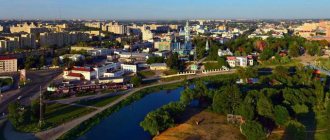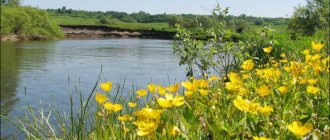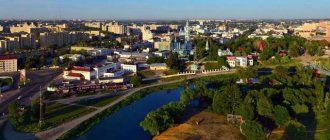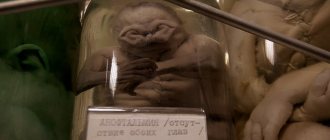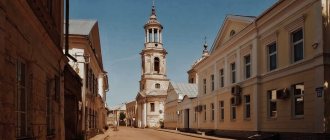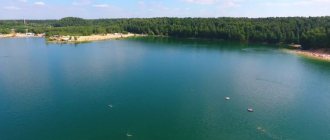The city of Kozlov (now Michurinsk) was founded a year earlier than Tambov, in 1635, as a fortress protecting the southern borders of Russia from attacks by the Crimean and Nogai Tatars. According to one version, the name of the fortress comes from the surname of the first settler Semyon Kozlov. According to another version, it comes from the name of the area “Kozlovo tract”, which occupied a significant part of modern Michurinsk. In ancient times, the tract was inhabited by wild goats, which lived here in large numbers. Despite the fact that today the city bears the name of the great scientist and breeder I.V. Michurin (renamed in 1932), on the modern coat of arms of the city you can still find the proud owner of horns and hooves. The remaining parts of the coat of arms indicate the multifaceted facets of life in a modern city.
The central part of modern Michurinsk is a single historical and architectural complex that emerged at the end of the 19th century. At this time, trade and handicrafts flourished in Kozlov. There were two factories in the city, one of them cast bells for the entire province, and railway workshops were built. The construction of the Ryazan-Kozlovskaya railway in 1865-1866, one of the first in Russia, contributed to the growth of the well-being of the townspeople. Beautiful merchant houses, richly decorated offices, mansions of factory owners and even a theater are being built in the city.
The city received the name “Michurinsk” in 1932 in honor of the biologist and breeder Ivan Vladimirovich Michurin, who glorified the city throughout the world. An interesting fact, because Michurin was still alive at that time (the first case in the history of Russia).
There is a lot to see and admire in Michurinsk. The city is famous for its museums, the number of which can be the envy of any regional center. The Museum-Estate of A. M. Gerasimov and the House-Museum of I. V. Michurin are memorial ones.
In 2003, Michurinsk became the first science city in Russia in the field of the agricultural-industrial complex. Continuing Michurin’s work, the city is developing, testing and producing therapeutic, preventive and dietary food of organic origin. The assortment of Michurin scientists includes nectars, compotes, drinks, berry jellies with low sugar content, dietary vegetable caviar, tomatoes with specified biochemical properties and more.
Michurinsk is famous for apples. Unique black soils, the experience of scientists and the latest technologies underlie the production of the most delicious and healthy Michurin apples. Every spring, the city, surrounded by acres of orchards, literally floats on a cloud of apple blossoms.
The name of our city
Until now, local local historians do not have a consensus on the origin of the name Kozlov-Michurinsk. Our regular reader V.B. Semyonov (Parkovaya St.) offers his original version.
In August 1635, Tsar Mikhail Fedorovich Romanov signed a Decree on the construction of a new fortress to defend Russian lands from raids by Nogai and Crimean Tatars. In search of the most “pleasing place,” the Tsar’s envoys Ivan Birkin and Mikhail Speshnev refused to build a new fortress at the Urlyapov settlement indicated in Moscow. “We examined the settlement and other places,” they reported in their letter to the capital, “and besides, sir, Kozlova Urochishche, where the city should be, we did not find a better place.” In the first years of its existence, the name of the new fortress changed several times. At first it was called the New City. This suggests that Tsar Mikhail had not yet decided on the name of the new city, since he intended its initial construction on the Urlyapov settlement. This is where the name of our city could come from - Urlyapov. However, this did not happen. In 1636, in the columns of the “Order Table” our city was listed as New Kozlov City or simply New Kozlov. The question arises: if there was New Kozlov, does that mean there was another, more ancient fortress with the same name somewhere? And where did the family of the Kozlovsky princes come from, how did the appanage Kozlovsky principality arise? Archival sources say that 20 kilometers east of the city of Vyazma, on the Zhizhaly River, the fortress town of Kozlov existed for a long time. Undoubtedly, the tsar himself and his inner circle knew about this. It is no coincidence that for some time they referred to the new city on the Kozlov tract as “New Kozlov City,” in contrast to Tambov, which did not have a historical counterpart. The first written mention of the fortified town of Kozlov, east of Vyazma, dates back to the middle of the 13th century. At that time, he controlled the ancient Old Moscow (Smolensk) road, which ran through the city of Mozhaisk. Later, another Smolensk road was built parallel to it in the direction of Gzhatsk. The founder of the famous princely family was Prince Vasily Fedorovich Fominsky, nicknamed Kureisha (XVth tribe from Rurik), who adopted the surname Kozlovsky from his Kozlovsky estate near Vyazma. His eldest grandson Roman Ivanovich in 1494 in the agreement between the Grand Duke of Moscow John III and the Grand Duke of Lithuania Alexander was mentioned as a Moscow subject, while the offspring of the younger grandson - Prince Lev Ivanovich - remained in the service in the Grand Duchy of Lithuania until the 20s of the 16th century, while retaining the rights to the Kozlovskaya volost near Vyazma according to the charter of the Polish Prince Casimir. In 1492, Grand Duke Ivan III annexed the fortress-city of Kozlov to the Moscow state. So it became a royal fiefdom on the border with the Grand Duchy of Lithuania. In Valery Yazvitsky’s book “Ivan III - Sovereign of All Rus'” it is mentioned that the tsar visited his patrimony - the city of Kozlov. The latest information about this fortified town dates back to 1616. That time, service people set off from Kozlov once again to defend Vyazma. The Polish-Lithuanian devastation at the beginning of the 17th century led to the destruction of the old fortified cities. Among them was the Kozlov fortress, which was completely destroyed. The war with Poland continued until 1667. In 1632, Tsar Mikhail Fedorovich built a new stone fortress in Vyazma. There is no doubt that he wanted to restore the old Kozlov fortress. Is that why our city was called New Kozlov or Kozlov-2? And only under Tsar Alexei Mikhailovich, who ceased to see Poland and Lithuania as the main enemies, from 1648 our city began to be called simply Kozlov. I would like to talk about the Kozlov Principality separately. It became an independent feudal estate (with an administrative center in the city of Kozlov) back in the 14th century under the rule of one of the branches of the Rurikovichs. The city of Kozlov was mentioned by the Grand Duke of Lithuania Olgerd in the list of conquered settlements by the Grand Prince of Moscow Dmitry Ivanovich in 1371 during the campaign against Lithuania. During the time of Ivan the Terrible, Vyazma and Kozlov were in the oprichnina and were considered the royal estates. In the Spiritual Letter of Tsar Ivan the Terrible it is said: “Yes, I give to my son Ivan... the city of Vyazma and Kozlov with volosts and roads and villages and all the duties and with everything that was attracted to Vyazma and Kozlov.” Subsequently, after the establishment of a new dynastic family in the country, all the former great princely estates passed to the Romanov boyars. Is this not where Tsar Michael’s desire to found a new town with the same name in memory of the lost patrimonial town comes from? By this time, only a settlement remained from ancient Kozlov. Until now, its remains are located half a kilometer north of the village of Kozlovtsy on the right bank of the Zhizhaly River, which is considered the most important archaeological monument in the Smolensk region.
How many people live in Morshansk?
The population as of January 1, 2022 was: 38,230. As of January 1, 2019, the city was in 404th place out of 1,115 cities in the Russian Federation in terms of population.
Interesting materials:
Who and when adopted the current Constitution of the Russian Federation? Who is the head of the Security Council of the Russian Federation? Who is the Minister of Foreign Affairs of the Russian Federation? Who are Russia's neighbors? Who is Russia's second-order neighbor? Who is the founder of the Bank of Russia? Who is the Supreme Commander-in-Chief of the Armed Forces of the Russian Federation and his powers in ensuring the security of the country? Who is the owner of the Russian Federation? Which Russian singer won Eurovision? Which Russian star gave birth late?
Streets of the city of Kozlov - Michurinsk
The streets of our city... Every day thousands of pedestrians rush along them, a great variety of motley cars rush by. The names habitually flash: Red, Soviet, Communist, Revolutionary, Marata...
Now they too are history. New names of city streets seem to have firmly sprouted in our consciousness, however, like frescoes covered with lime, no, no, and their true names will appear in the names of city stores: “On Moskovskaya” or “On Myasnitskaya”. Is it a coincidence?
Old city street names did not appear by chance. All of them were logically determined, and therefore original in their own way. Many of them adopted the names of the temples that existed in Kozlov, near which they originated or met along the way. This is how Cathedral and Voznesenskaya, Trinity and Arkhangelskaya, Nikolskaya and Uspenskaya appeared.
Kozlov. Tambov outpost
Other city streets set the direction and served as a kind of landmark. For example, Moscow pointed to the first throne; moving along Tambovskaya, the traveler ended up on the road leading to the provincial center, and along Lebedyanskaya - to neighboring Lebedyan. By the way, at the beginning of the 20th century, this longest city highway did not have access to the ancient Priyutskaya Square, but turned left, to the modern utility gates of the old building of the piston ring plant. At that time, the plant’s workshops were located away from the road, and it, bypassing the territory of the enterprise, smoothly flowed into the Great Road to Lebedyan, later called the Lipetsk Highway.
There were also streets in Kozlov, the names of which appeared due to their location. Thus, the Embankment was located along the edge of the city hill or river bank; The extreme one marked the city border; Zavodskaya - talked about a factory located nearby; Progonnaya - about the herds and herds of domestic animals being driven through it, and Myasnitskaya - about the numerous butcher shops located on it.
Kozlov. Arkhangelskaya street
There were also unofficial street names in old Kozlov. That is, it took place only in the oral speech of the townspeople. For example, for a long time, residents of Kozlov were well aware of Navoznaya Street. She passed at the foot of the city hill. And this unusual name appeared due to the horse trading stalls located near the Church of the Ascension - the venue for frequent horse markets and fairs. After the end of the trading day, there was a lot of scattered millet, hay and manure left on the square. Of course, it never occurred to anyone to clean up the sewage. At best, they were simply thrown to the foot of the mountain. As a result, the nameless street acquired such an unusual name. The originality of old-world street names lay in the fact that the same city highway had, as it were, an internal division determined by historically established patterns. For example, from Turmasovo station to Moskovskaya Zastava, the central city street was called Yamskaya. Moskovskaya Street went to modern school No. 18, then Moskovskaya Square began, reaching the Intercession Cathedral, it received the name Sobornaya, after which, up to the Tambov outpost, the main city street was called Pushkarskaya - in memory of the Pushkarskaya Sloboda that once existed on this site. Already in Soviet times, the Bolsheviks, having abolished the internal division of the street, “rebaptized” it along its entire length into Sovetskaya. The same thing happened with the parallel modern Marat, which from the Yamskaya to the Arkhangelsk Church was called Shatskaya, and from it to the Voznesenskaya was listed under the name of the Assumption.
Shatskaya street - Gerasimova, Lipetskoe highway - Lebedyanskaya Gogolevskaya - Piteinaya Goncharova - Invalid Darwin - Dostoevsky's Cossacks - Meadow International - Myasnitskaya MyasnayaKarla Marx - Sobornaya, Dmitrievskaya Communist - Troitskaya Komsomolskaya - Dorokhovskaya Krasnoarmeyskaya - Nikolskaya Red, January - Extreme Maxima Gorky - Palkin Marata Lane — Shatskaya, Uspenskaya Pionerskaya — Bakholdina Poltavskaya — Vyvodnaya Proletarskaya — Viceroyalty Revolutionary — Voznesenskaya Sadovaya, Stepana Razina — Kozhevinskaya Sovetskaya — Yamskaya, Moskovskaya, Moskovskaya Square, Cathedral Square, Pushkarskaya Sportivnaya — Nameless Ukrainian — Arkhangelskaya Filippova — Gostiny Ryad, Socialist
Buy books by Mikhail Belykh in stores in Michurinsk (ed.)
